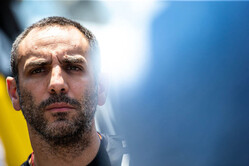


23/10/2018
NEWS STORY
 Cyril Abiteboul, Renault Sport Racing Managing Director: We enter the Mexican Grand Prix on the back of a strong result in Austin with both cars not only well inside the top ten, but placing 1-2 behind the leading teams, a result already obtained in Montréal earlier this season. After an admittedly tough few races, this result arrived at an important moment in our season, not only for the 14-point gain on our closest rivals, but also for the demonstration of the genuine potential of our "race team-car-drivers" combination.
Cyril Abiteboul, Renault Sport Racing Managing Director: We enter the Mexican Grand Prix on the back of a strong result in Austin with both cars not only well inside the top ten, but placing 1-2 behind the leading teams, a result already obtained in Montréal earlier this season. After an admittedly tough few races, this result arrived at an important moment in our season, not only for the 14-point gain on our closest rivals, but also for the demonstration of the genuine potential of our "race team-car-drivers" combination.
That said, there's little time to become too fixated on this result in Austin, as we immediately head to Mexico City for the next race. We will be working towards our usual performance expectations of a solid qualifying to put us in a strong position to achieve a good race.
There's yet a long way to go until reaching the chequered flag in Abu Dhabi and a lot of work to do. We are well aware our rivals will be giving it everything, and as our factories are fully turned towards 2019, our race team and our drivers will be doing just the same to ensure we're in the best possible position for Mexico, Brazil and Abu Dhabi to defend our position in the Constructors' Championship.
After a strong showing in Austin, Renault Sport Formula One Team next heads to the highest circuit on the calendar in Mexico City. Chassis Technical Director Nick Chester outlines the Formula 1 considerations of getting high.
What impact is there from running the car at such a high altitude?
Nick Chester: The high altitude affects many aspects of the car. The air is less dense, so that means there's less downforce and drag for a given wing setting, the air is less effective at cooling the brakes and engine and there's less oxygen going into the engine. The effect of the altitude on the engine is mitigated by the forced induction from the turbo, but the turbo has to spin faster to generate pressure. The effect of the air density on downforce is particularly notable as we run a Monaco level of wing in Mexico, but this only equates to an effective Monza level of downforce on the car.
What is notable about the layout of the circuit?
NC: There are a number of low speed corners, especially through the dramatic stadium section, and these types of corners tend to suit our car. It is a place where generating grip and tyre temperature is a challenge, because of the lack of effective downforce so this means a lot of work for drivers and engineers alike.
It's a relatively recent circuit so are we still learning about the track?
NC: We've learnt a lot already and there were some interesting lessons, particularly in terms of cooling from the first years and we know a lot more on this and set-up than when we first arrived. Simulations are very important, but there's nothing like getting out on track to learn all the nuances.
How did everything come together so well in Austin?
NC: It's been so close in the midfield - especially in qualifying - that a few small changes after scrutinising the data has made a significant difference. We had a good balance with the car from the off and that helped with the limited track time we had. The circuit configuration suited us better than Suzuka or Sochi and both Carlos and Nico delivered exceptionally well. Our race pace was very pleasing at Austin as we were able to manage fuel and tyres so that we had the additional pace when required to have pretty comfortable races for both drivers. Of course, we need to close the gap to the cars ahead of us - and that's what next year's car is about - but Austin was a good illustration of what is possible in 2018 and what we're aiming to achieve in the last three races.